HR Analytics: Critical and Challenging in Employment Relations
VerifiedAdded on 2023/06/07
|7
|2043
|248
Essay
AI Summary
This essay examines the critical yet challenging role of HR analytics in contemporary employment relations. It defines HR analytics as the application of talent data to improve business outcomes and explores its significance in understanding employee engagement, performance, and turnover. The essay highlights the benefits of HR analytics, such as providing data-backed insights for strategic decision-making, identifying trends, and improving employee relations. It also addresses the challenges, including data aggregation difficulties, the need for skilled personnel, and potential biases. The essay emphasizes the use of HR analytics in various HR functions, such as recruitment, training, and talent management. It concludes that while HR analytics is essential for building a positive workplace culture and enhancing employee relations, its effective implementation requires addressing data management, analytical expertise, and potential biases.
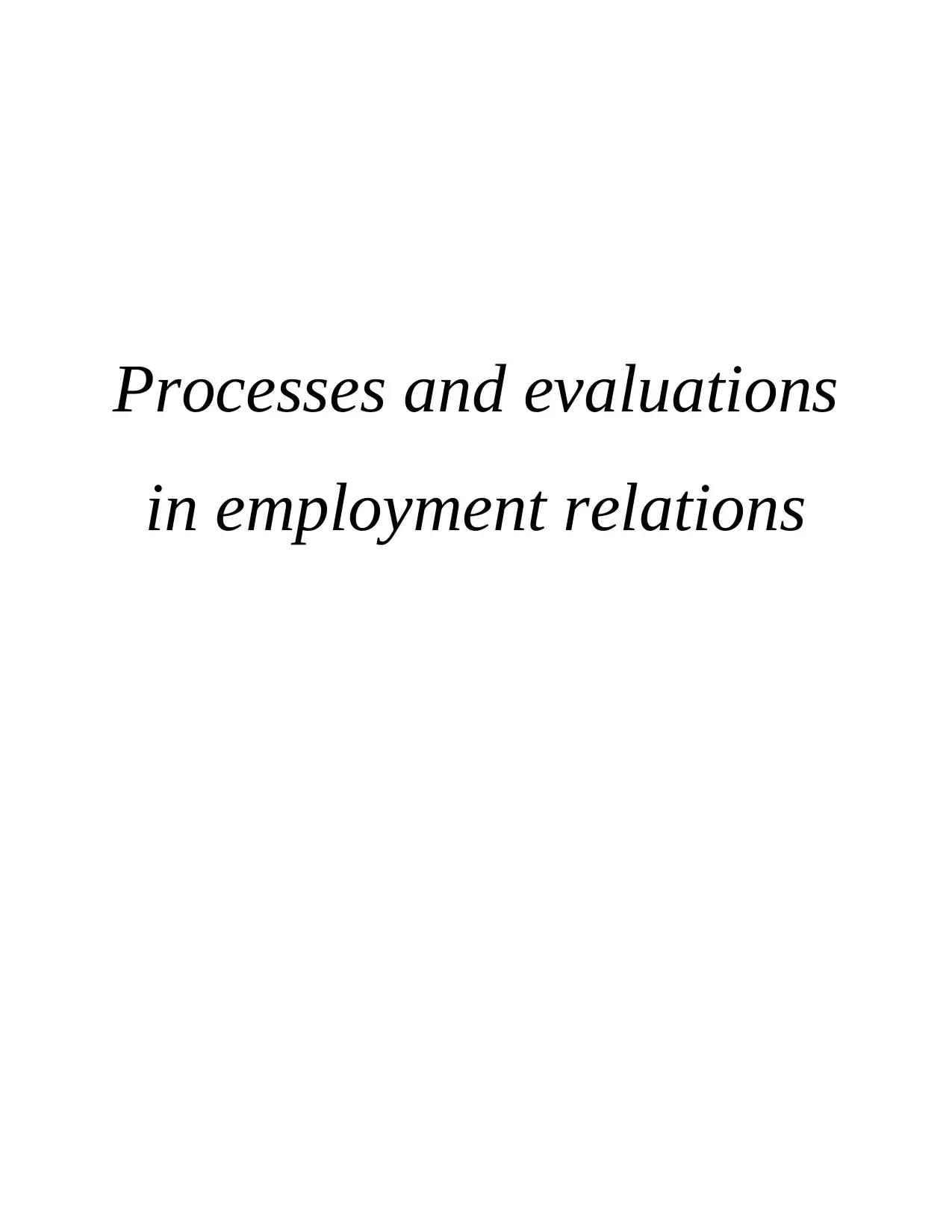
Processes and evaluations
in employment relations
in employment relations
Paraphrase This Document
Need a fresh take? Get an instant paraphrase of this document with our AI Paraphraser
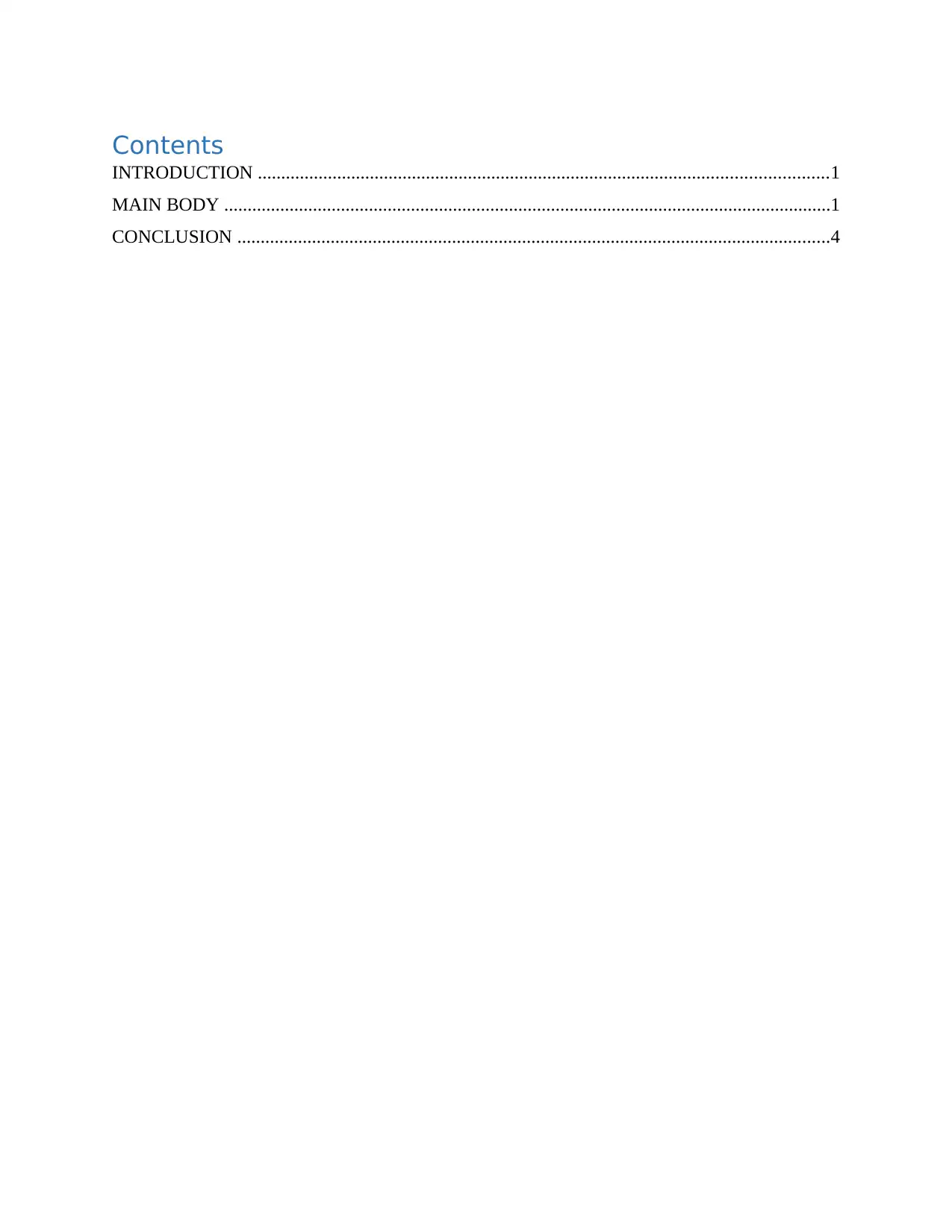
Contents
INTRODUCTION ..........................................................................................................................1
MAIN BODY ..................................................................................................................................1
CONCLUSION ...............................................................................................................................4
INTRODUCTION ..........................................................................................................................1
MAIN BODY ..................................................................................................................................1
CONCLUSION ...............................................................................................................................4
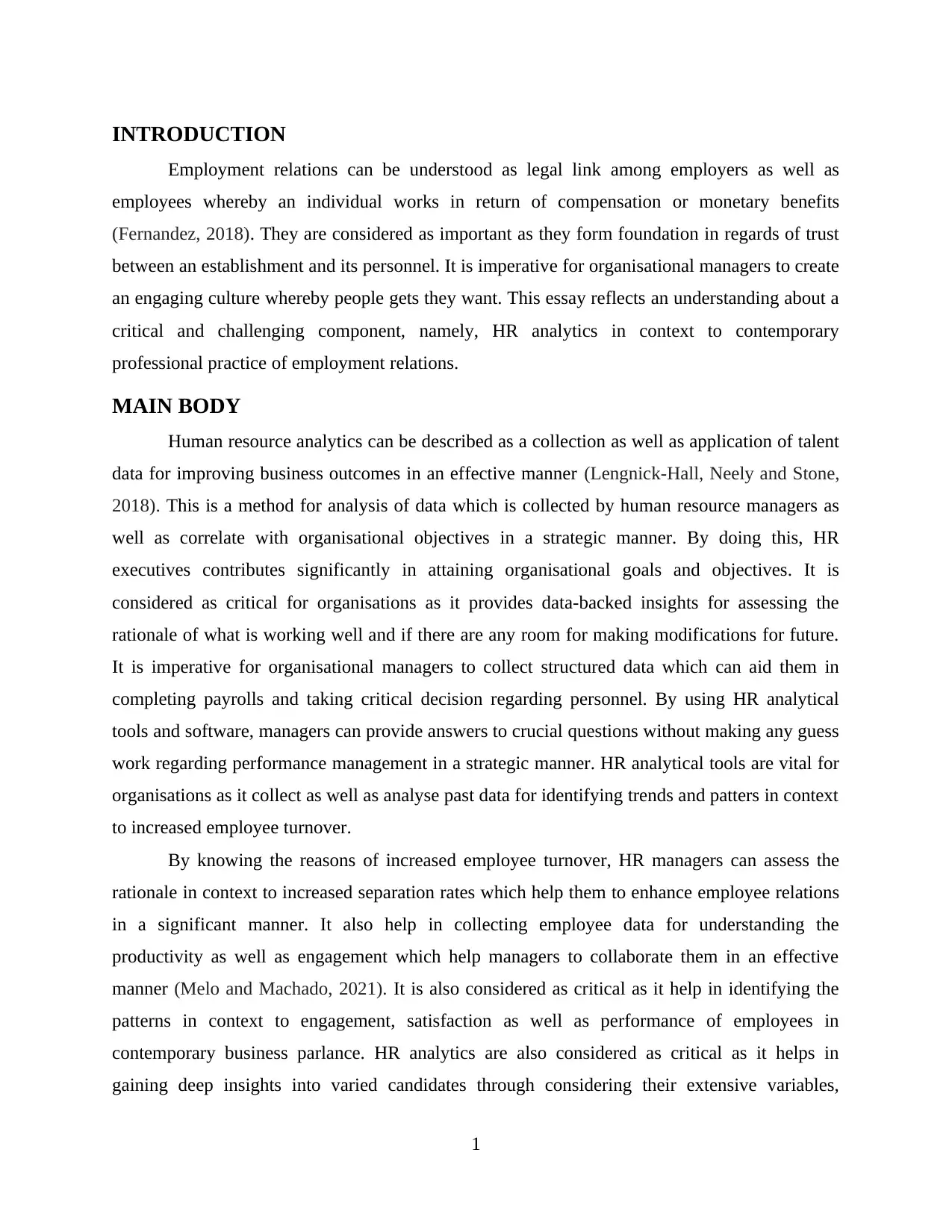
INTRODUCTION
Employment relations can be understood as legal link among employers as well as
employees whereby an individual works in return of compensation or monetary benefits
(Fernandez, 2018). They are considered as important as they form foundation in regards of trust
between an establishment and its personnel. It is imperative for organisational managers to create
an engaging culture whereby people gets they want. This essay reflects an understanding about a
critical and challenging component, namely, HR analytics in context to contemporary
professional practice of employment relations.
MAIN BODY
Human resource analytics can be described as a collection as well as application of talent
data for improving business outcomes in an effective manner (Lengnick-Hall, Neely and Stone,
2018). This is a method for analysis of data which is collected by human resource managers as
well as correlate with organisational objectives in a strategic manner. By doing this, HR
executives contributes significantly in attaining organisational goals and objectives. It is
considered as critical for organisations as it provides data-backed insights for assessing the
rationale of what is working well and if there are any room for making modifications for future.
It is imperative for organisational managers to collect structured data which can aid them in
completing payrolls and taking critical decision regarding personnel. By using HR analytical
tools and software, managers can provide answers to crucial questions without making any guess
work regarding performance management in a strategic manner. HR analytical tools are vital for
organisations as it collect as well as analyse past data for identifying trends and patters in context
to increased employee turnover.
By knowing the reasons of increased employee turnover, HR managers can assess the
rationale in context to increased separation rates which help them to enhance employee relations
in a significant manner. It also help in collecting employee data for understanding the
productivity as well as engagement which help managers to collaborate them in an effective
manner (Melo and Machado, 2021). It is also considered as critical as it help in identifying the
patterns in context to engagement, satisfaction as well as performance of employees in
contemporary business parlance. HR analytics are also considered as critical as it helps in
gaining deep insights into varied candidates through considering their extensive variables,
1
Employment relations can be understood as legal link among employers as well as
employees whereby an individual works in return of compensation or monetary benefits
(Fernandez, 2018). They are considered as important as they form foundation in regards of trust
between an establishment and its personnel. It is imperative for organisational managers to create
an engaging culture whereby people gets they want. This essay reflects an understanding about a
critical and challenging component, namely, HR analytics in context to contemporary
professional practice of employment relations.
MAIN BODY
Human resource analytics can be described as a collection as well as application of talent
data for improving business outcomes in an effective manner (Lengnick-Hall, Neely and Stone,
2018). This is a method for analysis of data which is collected by human resource managers as
well as correlate with organisational objectives in a strategic manner. By doing this, HR
executives contributes significantly in attaining organisational goals and objectives. It is
considered as critical for organisations as it provides data-backed insights for assessing the
rationale of what is working well and if there are any room for making modifications for future.
It is imperative for organisational managers to collect structured data which can aid them in
completing payrolls and taking critical decision regarding personnel. By using HR analytical
tools and software, managers can provide answers to crucial questions without making any guess
work regarding performance management in a strategic manner. HR analytical tools are vital for
organisations as it collect as well as analyse past data for identifying trends and patters in context
to increased employee turnover.
By knowing the reasons of increased employee turnover, HR managers can assess the
rationale in context to increased separation rates which help them to enhance employee relations
in a significant manner. It also help in collecting employee data for understanding the
productivity as well as engagement which help managers to collaborate them in an effective
manner (Melo and Machado, 2021). It is also considered as critical as it help in identifying the
patterns in context to engagement, satisfaction as well as performance of employees in
contemporary business parlance. HR analytics are also considered as critical as it helps in
gaining deep insights into varied candidates through considering their extensive variables,
1
⊘ This is a preview!⊘
Do you want full access?
Subscribe today to unlock all pages.

Trusted by 1+ million students worldwide
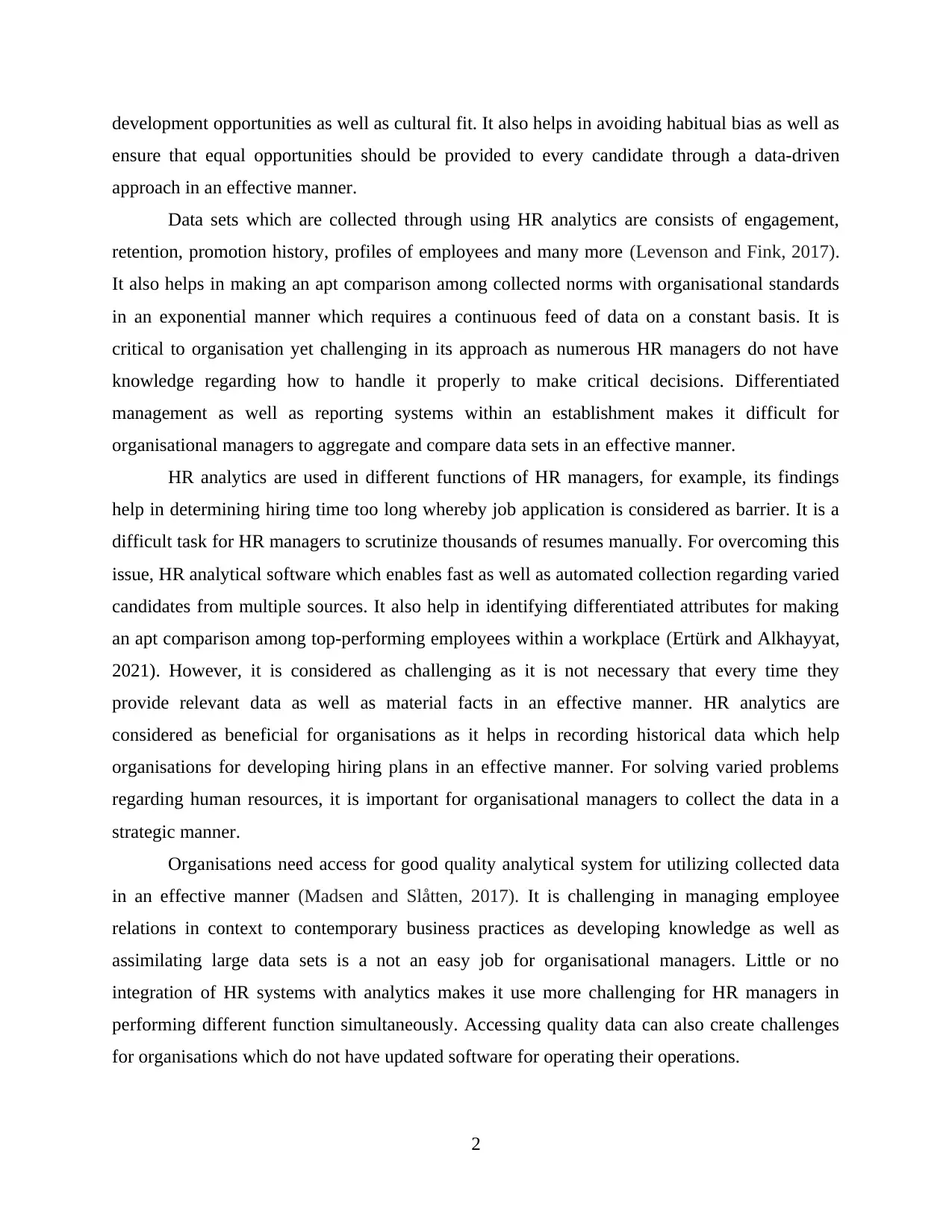
development opportunities as well as cultural fit. It also helps in avoiding habitual bias as well as
ensure that equal opportunities should be provided to every candidate through a data-driven
approach in an effective manner.
Data sets which are collected through using HR analytics are consists of engagement,
retention, promotion history, profiles of employees and many more (Levenson and Fink, 2017).
It also helps in making an apt comparison among collected norms with organisational standards
in an exponential manner which requires a continuous feed of data on a constant basis. It is
critical to organisation yet challenging in its approach as numerous HR managers do not have
knowledge regarding how to handle it properly to make critical decisions. Differentiated
management as well as reporting systems within an establishment makes it difficult for
organisational managers to aggregate and compare data sets in an effective manner.
HR analytics are used in different functions of HR managers, for example, its findings
help in determining hiring time too long whereby job application is considered as barrier. It is a
difficult task for HR managers to scrutinize thousands of resumes manually. For overcoming this
issue, HR analytical software which enables fast as well as automated collection regarding varied
candidates from multiple sources. It also help in identifying differentiated attributes for making
an apt comparison among top-performing employees within a workplace (Ertürk and Alkhayyat,
2021). However, it is considered as challenging as it is not necessary that every time they
provide relevant data as well as material facts in an effective manner. HR analytics are
considered as beneficial for organisations as it helps in recording historical data which help
organisations for developing hiring plans in an effective manner. For solving varied problems
regarding human resources, it is important for organisational managers to collect the data in a
strategic manner.
Organisations need access for good quality analytical system for utilizing collected data
in an effective manner (Madsen and Slåtten, 2017). It is challenging in managing employee
relations in context to contemporary business practices as developing knowledge as well as
assimilating large data sets is a not an easy job for organisational managers. Little or no
integration of HR systems with analytics makes it use more challenging for HR managers in
performing different function simultaneously. Accessing quality data can also create challenges
for organisations which do not have updated software for operating their operations.
2
ensure that equal opportunities should be provided to every candidate through a data-driven
approach in an effective manner.
Data sets which are collected through using HR analytics are consists of engagement,
retention, promotion history, profiles of employees and many more (Levenson and Fink, 2017).
It also helps in making an apt comparison among collected norms with organisational standards
in an exponential manner which requires a continuous feed of data on a constant basis. It is
critical to organisation yet challenging in its approach as numerous HR managers do not have
knowledge regarding how to handle it properly to make critical decisions. Differentiated
management as well as reporting systems within an establishment makes it difficult for
organisational managers to aggregate and compare data sets in an effective manner.
HR analytics are used in different functions of HR managers, for example, its findings
help in determining hiring time too long whereby job application is considered as barrier. It is a
difficult task for HR managers to scrutinize thousands of resumes manually. For overcoming this
issue, HR analytical software which enables fast as well as automated collection regarding varied
candidates from multiple sources. It also help in identifying differentiated attributes for making
an apt comparison among top-performing employees within a workplace (Ertürk and Alkhayyat,
2021). However, it is considered as challenging as it is not necessary that every time they
provide relevant data as well as material facts in an effective manner. HR analytics are
considered as beneficial for organisations as it helps in recording historical data which help
organisations for developing hiring plans in an effective manner. For solving varied problems
regarding human resources, it is important for organisational managers to collect the data in a
strategic manner.
Organisations need access for good quality analytical system for utilizing collected data
in an effective manner (Madsen and Slåtten, 2017). It is challenging in managing employee
relations in context to contemporary business practices as developing knowledge as well as
assimilating large data sets is a not an easy job for organisational managers. Little or no
integration of HR systems with analytics makes it use more challenging for HR managers in
performing different function simultaneously. Accessing quality data can also create challenges
for organisations which do not have updated software for operating their operations.
2
Paraphrase This Document
Need a fresh take? Get an instant paraphrase of this document with our AI Paraphraser
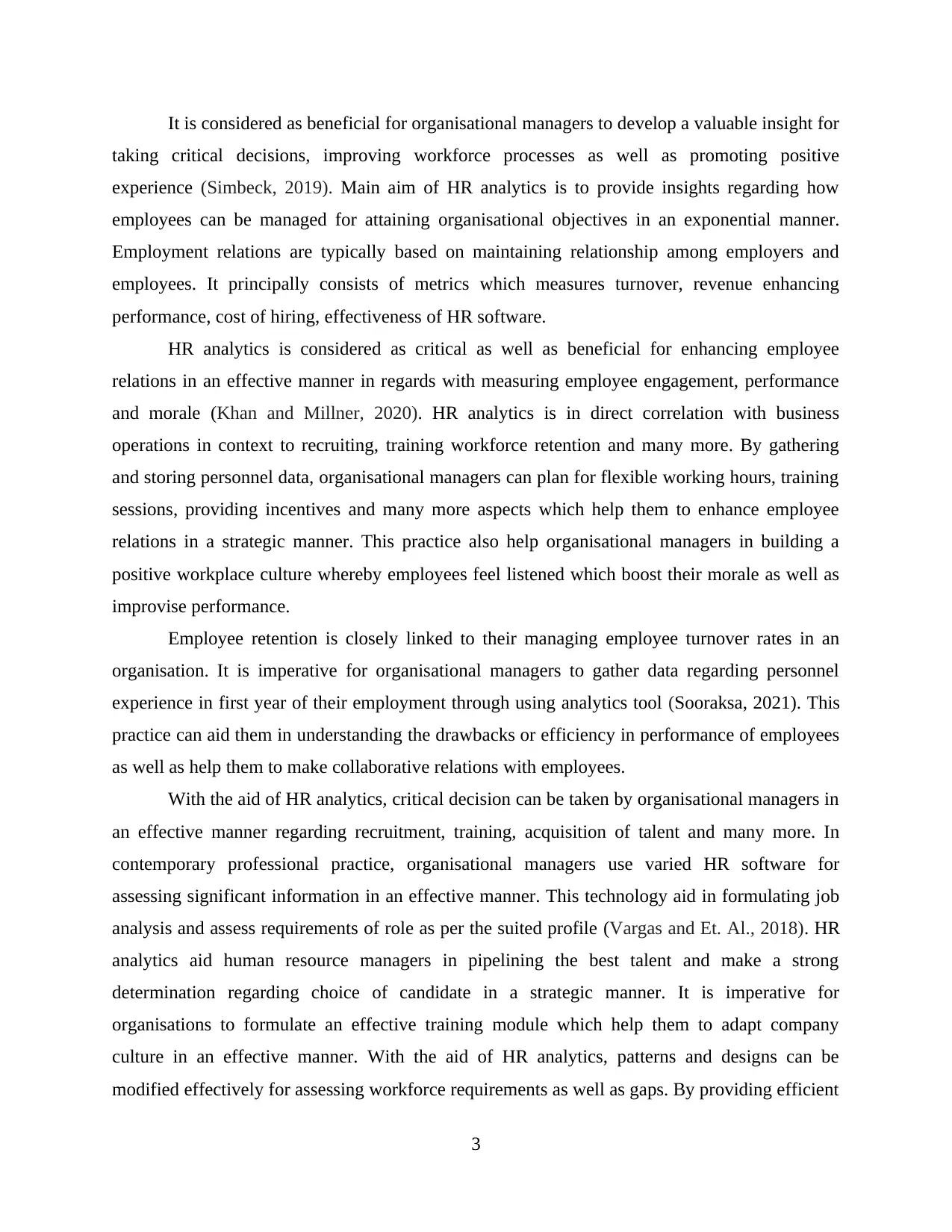
It is considered as beneficial for organisational managers to develop a valuable insight for
taking critical decisions, improving workforce processes as well as promoting positive
experience (Simbeck, 2019). Main aim of HR analytics is to provide insights regarding how
employees can be managed for attaining organisational objectives in an exponential manner.
Employment relations are typically based on maintaining relationship among employers and
employees. It principally consists of metrics which measures turnover, revenue enhancing
performance, cost of hiring, effectiveness of HR software.
HR analytics is considered as critical as well as beneficial for enhancing employee
relations in an effective manner in regards with measuring employee engagement, performance
and morale (Khan and Millner, 2020). HR analytics is in direct correlation with business
operations in context to recruiting, training workforce retention and many more. By gathering
and storing personnel data, organisational managers can plan for flexible working hours, training
sessions, providing incentives and many more aspects which help them to enhance employee
relations in a strategic manner. This practice also help organisational managers in building a
positive workplace culture whereby employees feel listened which boost their morale as well as
improvise performance.
Employee retention is closely linked to their managing employee turnover rates in an
organisation. It is imperative for organisational managers to gather data regarding personnel
experience in first year of their employment through using analytics tool (Sooraksa, 2021). This
practice can aid them in understanding the drawbacks or efficiency in performance of employees
as well as help them to make collaborative relations with employees.
With the aid of HR analytics, critical decision can be taken by organisational managers in
an effective manner regarding recruitment, training, acquisition of talent and many more. In
contemporary professional practice, organisational managers use varied HR software for
assessing significant information in an effective manner. This technology aid in formulating job
analysis and assess requirements of role as per the suited profile (Vargas and Et. Al., 2018). HR
analytics aid human resource managers in pipelining the best talent and make a strong
determination regarding choice of candidate in a strategic manner. It is imperative for
organisations to formulate an effective training module which help them to adapt company
culture in an effective manner. With the aid of HR analytics, patterns and designs can be
modified effectively for assessing workforce requirements as well as gaps. By providing efficient
3
taking critical decisions, improving workforce processes as well as promoting positive
experience (Simbeck, 2019). Main aim of HR analytics is to provide insights regarding how
employees can be managed for attaining organisational objectives in an exponential manner.
Employment relations are typically based on maintaining relationship among employers and
employees. It principally consists of metrics which measures turnover, revenue enhancing
performance, cost of hiring, effectiveness of HR software.
HR analytics is considered as critical as well as beneficial for enhancing employee
relations in an effective manner in regards with measuring employee engagement, performance
and morale (Khan and Millner, 2020). HR analytics is in direct correlation with business
operations in context to recruiting, training workforce retention and many more. By gathering
and storing personnel data, organisational managers can plan for flexible working hours, training
sessions, providing incentives and many more aspects which help them to enhance employee
relations in a strategic manner. This practice also help organisational managers in building a
positive workplace culture whereby employees feel listened which boost their morale as well as
improvise performance.
Employee retention is closely linked to their managing employee turnover rates in an
organisation. It is imperative for organisational managers to gather data regarding personnel
experience in first year of their employment through using analytics tool (Sooraksa, 2021). This
practice can aid them in understanding the drawbacks or efficiency in performance of employees
as well as help them to make collaborative relations with employees.
With the aid of HR analytics, critical decision can be taken by organisational managers in
an effective manner regarding recruitment, training, acquisition of talent and many more. In
contemporary professional practice, organisational managers use varied HR software for
assessing significant information in an effective manner. This technology aid in formulating job
analysis and assess requirements of role as per the suited profile (Vargas and Et. Al., 2018). HR
analytics aid human resource managers in pipelining the best talent and make a strong
determination regarding choice of candidate in a strategic manner. It is imperative for
organisations to formulate an effective training module which help them to adapt company
culture in an effective manner. With the aid of HR analytics, patterns and designs can be
modified effectively for assessing workforce requirements as well as gaps. By providing efficient
3
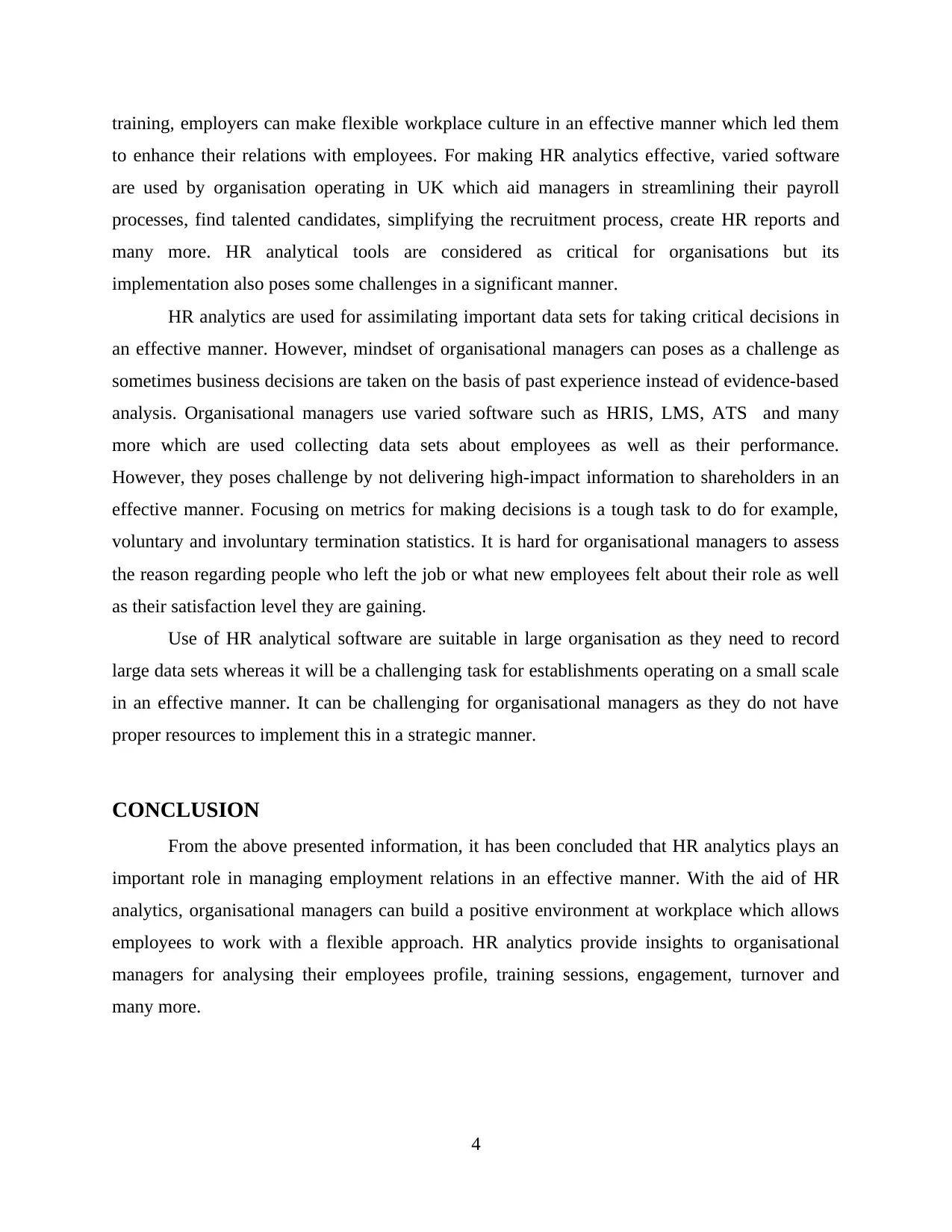
training, employers can make flexible workplace culture in an effective manner which led them
to enhance their relations with employees. For making HR analytics effective, varied software
are used by organisation operating in UK which aid managers in streamlining their payroll
processes, find talented candidates, simplifying the recruitment process, create HR reports and
many more. HR analytical tools are considered as critical for organisations but its
implementation also poses some challenges in a significant manner.
HR analytics are used for assimilating important data sets for taking critical decisions in
an effective manner. However, mindset of organisational managers can poses as a challenge as
sometimes business decisions are taken on the basis of past experience instead of evidence-based
analysis. Organisational managers use varied software such as HRIS, LMS, ATS and many
more which are used collecting data sets about employees as well as their performance.
However, they poses challenge by not delivering high-impact information to shareholders in an
effective manner. Focusing on metrics for making decisions is a tough task to do for example,
voluntary and involuntary termination statistics. It is hard for organisational managers to assess
the reason regarding people who left the job or what new employees felt about their role as well
as their satisfaction level they are gaining.
Use of HR analytical software are suitable in large organisation as they need to record
large data sets whereas it will be a challenging task for establishments operating on a small scale
in an effective manner. It can be challenging for organisational managers as they do not have
proper resources to implement this in a strategic manner.
CONCLUSION
From the above presented information, it has been concluded that HR analytics plays an
important role in managing employment relations in an effective manner. With the aid of HR
analytics, organisational managers can build a positive environment at workplace which allows
employees to work with a flexible approach. HR analytics provide insights to organisational
managers for analysing their employees profile, training sessions, engagement, turnover and
many more.
4
to enhance their relations with employees. For making HR analytics effective, varied software
are used by organisation operating in UK which aid managers in streamlining their payroll
processes, find talented candidates, simplifying the recruitment process, create HR reports and
many more. HR analytical tools are considered as critical for organisations but its
implementation also poses some challenges in a significant manner.
HR analytics are used for assimilating important data sets for taking critical decisions in
an effective manner. However, mindset of organisational managers can poses as a challenge as
sometimes business decisions are taken on the basis of past experience instead of evidence-based
analysis. Organisational managers use varied software such as HRIS, LMS, ATS and many
more which are used collecting data sets about employees as well as their performance.
However, they poses challenge by not delivering high-impact information to shareholders in an
effective manner. Focusing on metrics for making decisions is a tough task to do for example,
voluntary and involuntary termination statistics. It is hard for organisational managers to assess
the reason regarding people who left the job or what new employees felt about their role as well
as their satisfaction level they are gaining.
Use of HR analytical software are suitable in large organisation as they need to record
large data sets whereas it will be a challenging task for establishments operating on a small scale
in an effective manner. It can be challenging for organisational managers as they do not have
proper resources to implement this in a strategic manner.
CONCLUSION
From the above presented information, it has been concluded that HR analytics plays an
important role in managing employment relations in an effective manner. With the aid of HR
analytics, organisational managers can build a positive environment at workplace which allows
employees to work with a flexible approach. HR analytics provide insights to organisational
managers for analysing their employees profile, training sessions, engagement, turnover and
many more.
4
⊘ This is a preview!⊘
Do you want full access?
Subscribe today to unlock all pages.

Trusted by 1+ million students worldwide
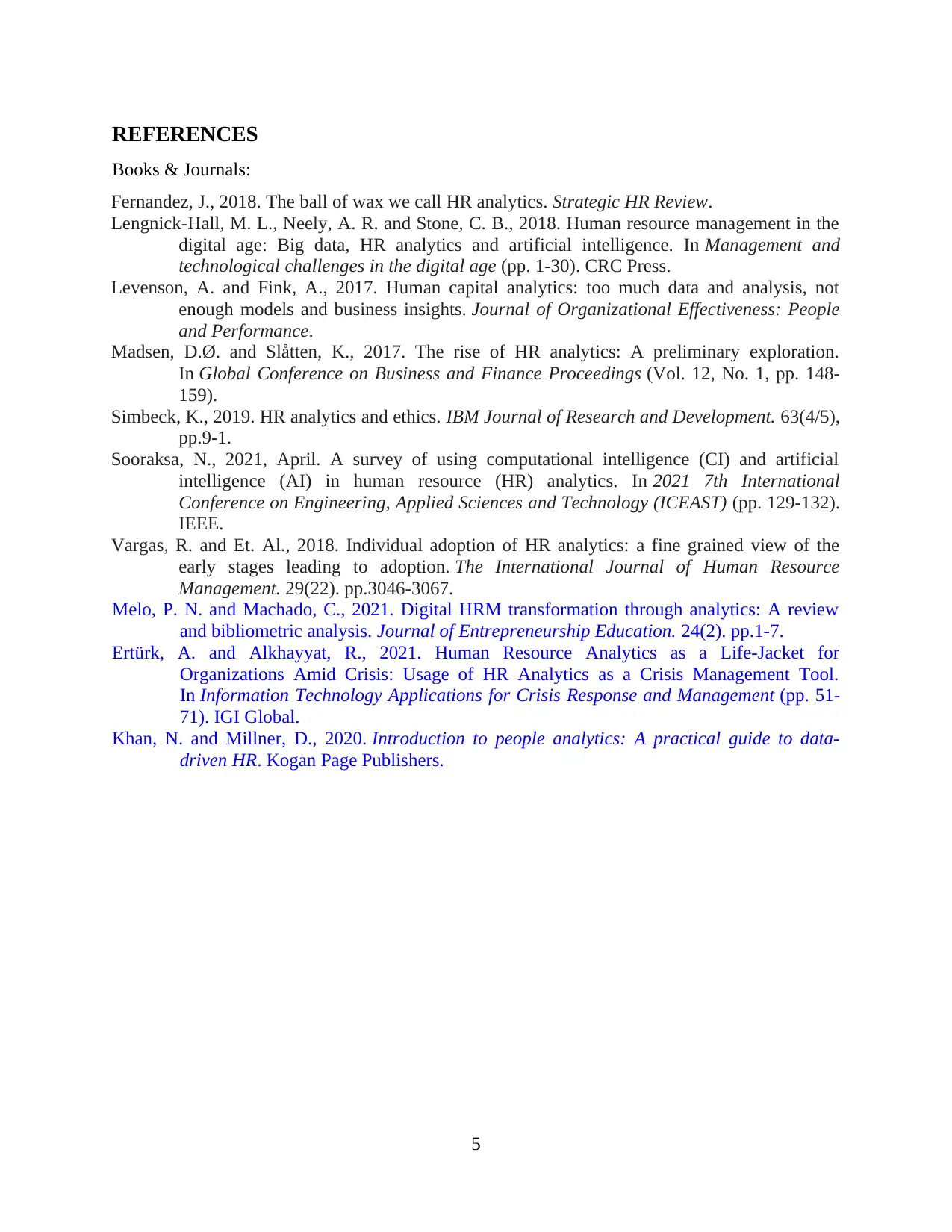
REFERENCES
Books & Journals:
Fernandez, J., 2018. The ball of wax we call HR analytics. Strategic HR Review.
Lengnick-Hall, M. L., Neely, A. R. and Stone, C. B., 2018. Human resource management in the
digital age: Big data, HR analytics and artificial intelligence. In Management and
technological challenges in the digital age (pp. 1-30). CRC Press.
Levenson, A. and Fink, A., 2017. Human capital analytics: too much data and analysis, not
enough models and business insights. Journal of Organizational Effectiveness: People
and Performance.
Madsen, D.Ø. and Slåtten, K., 2017. The rise of HR analytics: A preliminary exploration.
In Global Conference on Business and Finance Proceedings (Vol. 12, No. 1, pp. 148-
159).
Simbeck, K., 2019. HR analytics and ethics. IBM Journal of Research and Development. 63(4/5),
pp.9-1.
Sooraksa, N., 2021, April. A survey of using computational intelligence (CI) and artificial
intelligence (AI) in human resource (HR) analytics. In 2021 7th International
Conference on Engineering, Applied Sciences and Technology (ICEAST) (pp. 129-132).
IEEE.
Vargas, R. and Et. Al., 2018. Individual adoption of HR analytics: a fine grained view of the
early stages leading to adoption. The International Journal of Human Resource
Management. 29(22). pp.3046-3067.
Melo, P. N. and Machado, C., 2021. Digital HRM transformation through analytics: A review
and bibliometric analysis. Journal of Entrepreneurship Education. 24(2). pp.1-7.
Ertürk, A. and Alkhayyat, R., 2021. Human Resource Analytics as a Life-Jacket for
Organizations Amid Crisis: Usage of HR Analytics as a Crisis Management Tool.
In Information Technology Applications for Crisis Response and Management (pp. 51-
71). IGI Global.
Khan, N. and Millner, D., 2020. Introduction to people analytics: A practical guide to data-
driven HR. Kogan Page Publishers.
5
Books & Journals:
Fernandez, J., 2018. The ball of wax we call HR analytics. Strategic HR Review.
Lengnick-Hall, M. L., Neely, A. R. and Stone, C. B., 2018. Human resource management in the
digital age: Big data, HR analytics and artificial intelligence. In Management and
technological challenges in the digital age (pp. 1-30). CRC Press.
Levenson, A. and Fink, A., 2017. Human capital analytics: too much data and analysis, not
enough models and business insights. Journal of Organizational Effectiveness: People
and Performance.
Madsen, D.Ø. and Slåtten, K., 2017. The rise of HR analytics: A preliminary exploration.
In Global Conference on Business and Finance Proceedings (Vol. 12, No. 1, pp. 148-
159).
Simbeck, K., 2019. HR analytics and ethics. IBM Journal of Research and Development. 63(4/5),
pp.9-1.
Sooraksa, N., 2021, April. A survey of using computational intelligence (CI) and artificial
intelligence (AI) in human resource (HR) analytics. In 2021 7th International
Conference on Engineering, Applied Sciences and Technology (ICEAST) (pp. 129-132).
IEEE.
Vargas, R. and Et. Al., 2018. Individual adoption of HR analytics: a fine grained view of the
early stages leading to adoption. The International Journal of Human Resource
Management. 29(22). pp.3046-3067.
Melo, P. N. and Machado, C., 2021. Digital HRM transformation through analytics: A review
and bibliometric analysis. Journal of Entrepreneurship Education. 24(2). pp.1-7.
Ertürk, A. and Alkhayyat, R., 2021. Human Resource Analytics as a Life-Jacket for
Organizations Amid Crisis: Usage of HR Analytics as a Crisis Management Tool.
In Information Technology Applications for Crisis Response and Management (pp. 51-
71). IGI Global.
Khan, N. and Millner, D., 2020. Introduction to people analytics: A practical guide to data-
driven HR. Kogan Page Publishers.
5
1 out of 7
Related Documents
Your All-in-One AI-Powered Toolkit for Academic Success.
+13062052269
info@desklib.com
Available 24*7 on WhatsApp / Email
![[object Object]](/_next/static/media/star-bottom.7253800d.svg)
Unlock your academic potential
Copyright © 2020–2025 A2Z Services. All Rights Reserved. Developed and managed by ZUCOL.




